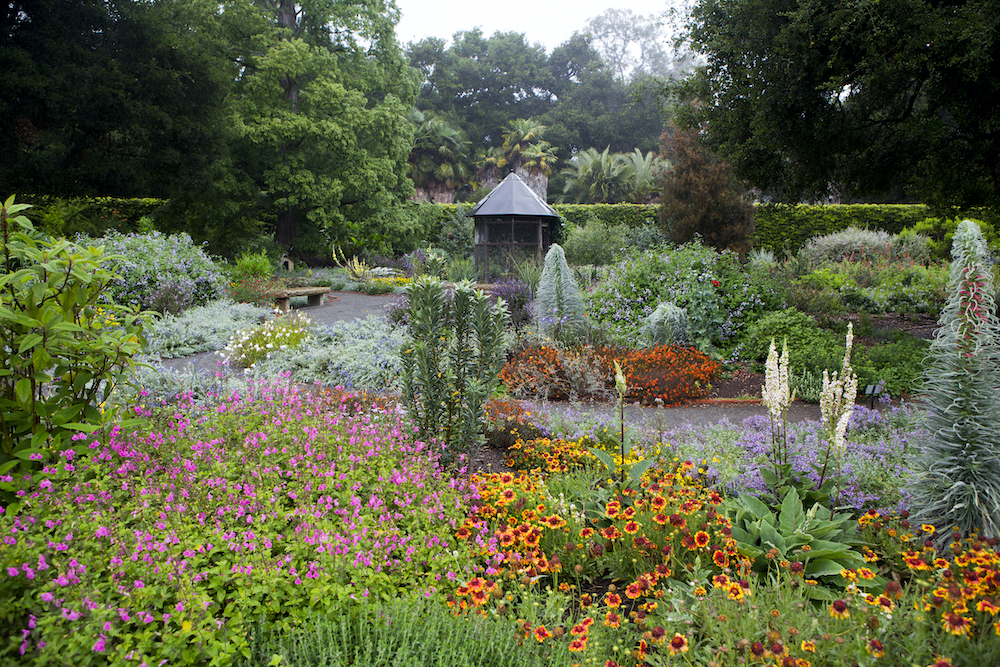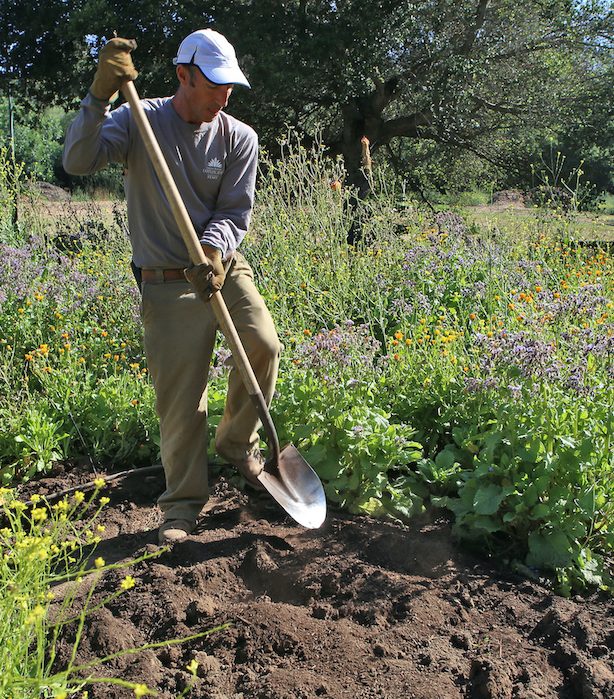Lotusland’s Sustainability Symposium Part 2 Dishes the Dirt

“I was already way into entomology as a child. I was collecting the most dangerous insects; the giant tarantula – they’re the most painful bite known to man – the black Tarantula Wasp with the orange wings, the most painful sting you can receive. I’d pin out 10 of these giant wasps at age nine, hand it to my mom. ‘Here’s my latest collection!’ She would scream and hurl it out the window. So I was already prepped for this.”
Okay? Welcome to Corey Welles, the effervescent magus who for some 33 years has been lavishing his regenerative (and insectoid) expertise on our hometown Eden – a madcap floral hallucination called Lotusland. Think of this unique public garden as a kaleidoscope with roots. Lotusland is also a center of excellence whose holistic, self-perpetuating ecosystem is a radiant microcosm of the busybody machinery the natural world has spent 3.7 billion years perfecting. Welles is Lotusland’s “Manager of Sustainability” (one of those titles that stupendously understates), and in September will be a keynote speaker at the aptly named Sustainability Symposium Part 2; a follow-up to the popular sustainability confab that Lotusland offered in April of this year.
Like the first, this gathering will be held at the historic old lemon-packing plant in Santa Paula. The theme of the symposium is largely to do with bringing these grand sustainable practices to bear on the home garden. The living soil, the insect community, the roiling, happy biome that drives the surface of the Earth to push actual food out of ordinary dirt – this jaw-dropping Cycle of Life can be writ small enough to occupy a few potted plants on your sun-splashed terrace. Regenerative avatar Stacy Pulice, a force of nature in her own right, will be moderating the symposium.
“Lotusland invites us to come and connect with community around these subjects,” she says. “And that’s what I think is so genius about what Lotusland is doing. They’re creating a gathering space. And it’s because of (globally revered landscape magician) Eric Nagelmann. It was his brainstorm. And they just said yes, because he’s Eric! We’re really lucky to have this kind of talent that only Lotusland could attract. These people are extremely knowledgeable, fascinating in presentation, and diverse in the ways they’ve come to sustainable horticulture.” How will the symposium’s guest speakers elevate us? Pulice counts the ways.

“Natasha Elliott is an advocate of farming restoration ecology. She’s a landscape architect and wants to talk about water, the ways we’ve commodified it. We need to rethink it in terms of reciprocity, adding back in. Some other cultures have built these practices into the way they understand nature and the planet’s resources.” Guest speaker Andy Sheaffer was an engineering contractor who started farming 15 years or so ago. When someone close to him fell ill with an autoimmune disorder, he started doing research on the Herbicide That Shall Not Be Named; that most popular and widely used herbicide in the world, whose active ingredient is glyphosate. “He found out the mechanism that goes to work in the plant body does its thing in the human body, too,” Pulice says. “He went pesticide free, herbicide free, and became very deeply involved in regenerative farming.” The truism that there is no more feverish acolyte than the newish convert may explain why these speakers are in such demand and speak with such enthused authority. They’ve long since put their discoveries into practice and want to share.
“Thomas Lloyd-Butler is a seventh-generation owner of a Saticoy property that is a model of diversity,” Pulice says. “He has orchards, he has row crops, he has a Victorian garden, he has collections.” Lloyd-Butler’s holdings are a master class in the seamless machinery of biodiversity. “He’s going to talk about what he calls his garden in the orchard; the pollinators, the flowering plants, the natural attraction of habitat birds to the garden. He’s also going to talk about stump gardens, which is just where you leave a stump to rot into the ground. That brings in the mycorrhizal factor, which we’re learning creates a huge communication and nutrient exchange.” Mycorrhiza is all about the fungus/green plant relationship and the loudmouth soil biology and chemistry the friendship activates. It’s been estimated that all the humans that have ever populated the Earth number around 117 billion. As it happens, that is about how many individual microorganisms occupy two fulsome handfuls of healthy dirt. The stuff you got yelled at for tracking into the house as a kid? When not stuck to your sneakers, it is a living, madly organized biome – each teaspoon of dirt, a Manhattan of interwoven, jostling micro-denizens busily doing their thing. We just need to get out of the way.
“You remember the super cell that roared through Montecito,” Welles says. “I came in the next day. It was a beautiful paradise here. Nothing changed. The soil here is stitched together with roots and the glue of all those living components that make it up.” Lotusland’s Corey Welles is himself a high-octane biome in his own right, or a Roman candle with a short fuse. How to light it? The word “hello” does the trick.
“I take one drop out of a hundred gallons of compost tea, put it under my microscope at 400 power and look at the organisms. I just make sure that I have amoebas, and protozoa with flagella swimming all around, eating the bacteria, pecking away at things. I’m growing so many types of mites and other beneficial predators, no damaging insect has a chance, no soil disease can take hold. This is a diverse, super tight ecological balance!” Not everyone can holler about mites and protozoa with such unbridled joy. And was there ever a more visual attestation to Life’s glowing madhouse than Ganna Walska’s garden? The woman incandesced through every joyous minute of her unorthodox time on Earth. The similarly spark-throwing dynamo that is Corey Welles could be her handpicked steward. Corey’s energy is that of Lotusland. And vice versa.
“It’s like wolves and deer. You get too many deer, then the wolf population starts growing. You run out of deer, the wolves die off, right? We’re always playing with these balances…” Welles’ mastery of soil agronomy, of biome care and feeding, of balance – his frank and loving infatuation with the ordered hurricane that is Life – has served Lotusland well, to put it mildly. His keynote at the September 9 Symposium 2 will blow the doors off. He and the other speakers will be talking about the grandness and magic of natural eco-systems you can install in your backyard. No big deal. With any luck, we’re all headed back to the garden.
“We’re just counting the butterflies and putting in new plants,” Welles says through an audible grin. His plans happily exceed his own expiration date, not that folks like Ganna Walska and Corey Welles ever really exit the room. “You know how long a Cycad can live, Jeff? A thousand years. I’m not planning for next year. I’m looking out a thousand years! And I have a good chance of making it.”
Lotusland Sustainability Symposium: Part Two
September 9, 1 pm to 4pm
Historic Lemon Packing Plant, Santa Paula
$10 ticket includes access to symposium, parking, and complimentary refreshments
Call 805-969-9990 or visit lotusland.org for more information








You must be logged in to post a comment.